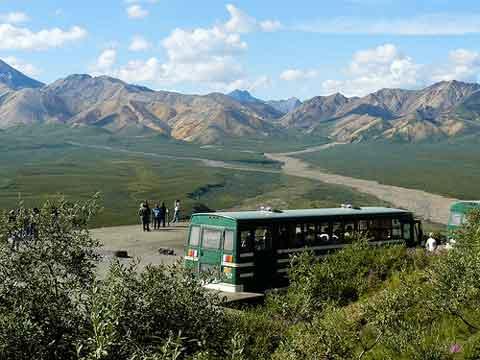Denali National Park and Preserve offers one of the premier wildlife viewing opportunities in the country, along with superb scenery, vast wilderness areas … and that famous mountain. Faced with growing visitation, the park is pondering how to manage vehicle access, and you're invited to participate in the discussion.
The park concessioner had been offering bus tours on the only road into the park's interior since the mid-1920s, but because simply getting to the area in those days was an adventure, traffic was limited. All that changed in 1972, when the opening of the George Parks Highway created a direct corridor from Anchorage and Fairbanks to Denali.
Anticipating a big jump in visitation, the park implemented a mandatory visitor transportation system that same year—one of the such systems in the National Park System.
Under that transportation system, only visitors with overnight or other special use permits have been allowed to drive their vehicles beyond the first 15 miles of the 90-mile-long park road; other visitors could ride buses for day trips of varying length into the park. The purpose of this system was to protect wildlife viewing opportunities, wildlife health and habitat, and the wilderness character of the park road, and that decision back in 1972 to limit vehicle traffic proved to be a good one.
In just over a decade following the completion of the Parks Highway, visitation to Denali increased by about 900%. Denali is now one of the most visited subarctic national parks in the world, and the vast majority that activity is focused along the 90-mile park road. Annual visitation is nearing 500,000, and about 90 percent of that occurs during the summer season.
In 1986 the park's General Management Plan established a limit of 10,512 motor vehicle trips on the Park Road during the core season from Memorial Day weekend to after Labor Day. Is that number—and the current transportation system—the right approach for the future? Park officials are making a serious effort to find out.
The transportation system has been in place since 1972 and the seasonal road limit has been in place since 1986. The entire transportation system has never been comprehensively evaluated with the goal of answering the question: Are we providing the best transportation system possible—one that provides the highest quality visitor experience and protects park resources? It is time to answer that question.
Faced with increasing visitation and pressure to defend or change the limits to road traffic, park managers have designed a study to develop a greater understanding of the impacts of traffic volume and traffic patterns on the physical, biological, and social environment of the park.
In 2006, Denali began a multidisciplinary study dubbed the Denali Park Road Capacity Study; the goal is learn how to provide the best visitor experience along the road while protecting wildlife and other park values. You'll also find some links to good information about the study here.
Information gained from that study is being used to develop the Denali Park Road Vehicle Management Plan and Environmental Impact Statement (EIS), and the park is looking for some input as that plan is being developed.
If you're thinking this sounds like just another bureaucratic exercise, information from the park summarizes the importance of this effort:
We are approaching the seasonal road limit in the next five years and may reach it under the current system. Visitors will soon be dissatisfied if they can’t access the park … [but] if the limit is increased without scientific research and a thoughtful planning process, the quality of the visitor experience could be degraded.
We are being proactive, trying to ensure that we have the most efficient and effective transportation system possible that meets the needs of visitors while protecting the park resource values they came to experience.
Public input is important, but it's most effective if those making comment have some basic information on the issues. The park has prepared a "Denali Park Road Workbook" which provides "background on the need for the EIS and preliminary concepts for possible alternatives," and they're looking for comments on that document.
You can download a copy of the workbook ; after you've done so and are ready to make some comments, you can click here to download the comment form.
The form is designed to be printed and mailed—the address is pre-printed on the document. If you'd prefer, you can fax a completed form to 907-733-1465.
Although the comment form makes life a bit easier for the planners, you're also welcome to submit your ideas via the NPS planning website.
All comments must be postmarked or submitted on-line by 11:59 p.m. Mountain Time on March 1, 2010.
If you're in—or are looking for a reason to visit Alaska in February—you can also attend any of three upcoming public workshops, which will include a discussion of the preliminary concepts in the workbook, information on how the alternatives will be developed, and the opportunity to share your suggestions with park staff members.
Those meetings will be held in mid-February in Anchorage, Fairbanks and at the park. Details are available here.
Paul Anderson, Superintendent of Denali National Park and Preserve, summarizes the importance—and challenges—involved in this process:
What one can experience on a trip out the Park Road can be awe-inspiring—from the views of Mount McKinley looming large on the horizon to hillsides awash with brilliant purple wildflowers to the sight of a mother grizzly and her cubs snoozing on the tundra on a warm summer’s day. But there remains the question of how many people can take advantage of such opportunities at any one time before the experiences are diminished and wildlife is adversely affected.
The park is trying hard to find the answer to that question. If you're interested in the outcome, here's a chance to take part in the discussion.




Add comment